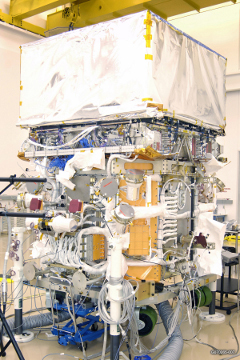Fermi Gamma-Ray Space Telescope after the integration of the burst monitor: Known as the Gamma-ray Large Area Space Telescope prior to launch, the Fermi telescope includes two primary instruments: the Large Area Telescope with which astronomers can observe and study active galactic nuclei and pulsars, and search for other high-energy phenomena, as well as dark matter signatures; and the Gamma-ray Burst Monitor to study gamma-ray bursts. This image shows the assembled telescope in the clean room prior to launch.
Credit: NASA/General Dynamics
While I theorize a lot now about how supernova explosions happen, I also still like to think about GRBs. I have come up with other ideas for sources of GRBs, like comets that interact with the magnetic fields of neutron stars, or neutron stars that accrete explosion matter and become black holes, thereby interrupting the current that supports the twisted magnetic field of the neutron star. There is no way to test my theories yet but we are still learning about GRBs. (Keep an open mind. We’ve been surprised before.)
We as scientists are still trying to figure out just how they happen. It’s still a major scientific problem in astrophysics, and it's a challenge to all our ingenuity to imagine what could possibly be doing it. How fitting it is that the next generation gamma-ray mission to follow in the footsteps of Compton is the Fermi Gamma Ray Space Telescope.
So out of discussions leading to the security of our nuclear weapons evolved not only perestroika, but also a constant reminder of the limitations of and challenges to our understanding of gamma-ray bursts.


